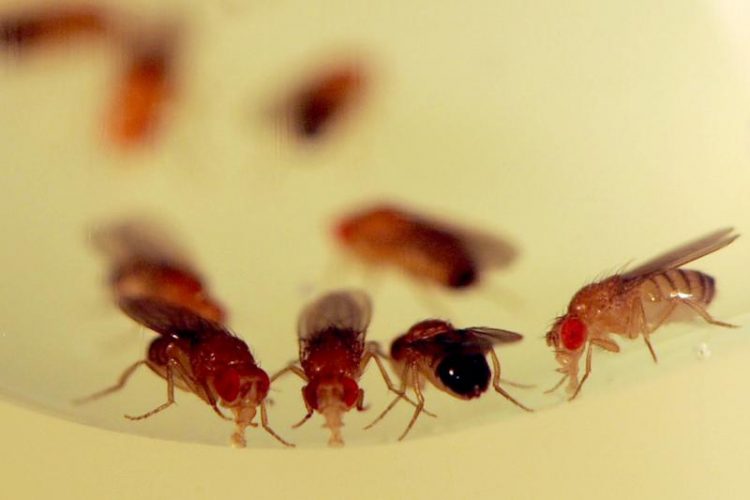Genome-based diets maximise growth, fecundity, and lifespan

Researchers use the fruit fly Drosophila melanogaster for their studies on genome-based diet. Dr. Sebastian Grönke / Max Planck Institute for Biology of Ageing
What is the best path to a long and healthy life? Scientists had a relatively simple answer for many years: less food. But it turned out that this could have unpleasant consequences. Experiments showed that putting flies or mice on diet could impair their development and fecundity. How could we take advantage of the beneficial effects of dieting, and at the same time avoid the damaging effects?
Genome-based diet
Scientists at the Max Planck Institute for Biology of Ageing in Cologne and UCL Institute of Healthy Ageing in London have now designed a diet based on the model organism’s genome. In the study, published today in Cell Metabolism, they calculated the amount of amino acids a fruit fly would need, thereby defining the diet’s amino acid composition.
“The fly genome is entirely known. For our studies we used only the sections in the genetic material that serve as templates for protein assembly – the exons, which collectively make up the ‘exome’. Then we calculated the relative abundance of each amino acid in the exome, and designed a fly diet that reflects this amino acid composition”, explains George Soultoukis, scientist in the department of Linda Partridge, director at the Max Planck Institute for Biology of Ageing in Cologne and at the UCL Institute of Healthy Ageing in London.
Using a holidic fly diet previously developed by the team to enable manipulation of individual nutrients such as amino acids, the group found that flies eating this exome-matched diet develop a lot faster, grow bigger in size, and lay more eggs compared to flies fed a standard diet. Remarkably, the flies on the exome-matched diet lived as long as slower-growing, fewer-egg-laying flies fed with “standard” diets. “The flies that had free access to the exome-matched diet even ate less than controls. Thus, high quality protein, as defined by the genome, appears to have a higher satiety value”, said Matthew Piper, who conducted part of the work at UCL and is now working at Monash University.
The study also found that similar phenomena may occur in mice, and future mouse work could further improve our understanding of how and why diets affect mammalian lifespan. “Our aim now is to characterize the effects of genome-based diets upon mammalian lifespan”, says Soultoukis.
Human diet
In theory this approach is applicable to all organisms with a sequenced genome – including humans. Soultoukis explains: “Dietary interventions based on amino acids can be a powerful strategy for protecting human health. Obviously factors such as age, gender, health, and personal lifestyle also have to be taken into account. Future studies may still employ novel -omics data to design diets whose amino acid supply matches the needs of an organism with even higher precision. Understanding why we need amino acids in the amounts we do will be key, and such studies provide novel and powerful insights into the vital interactions between nature and nurture”.
http://www.age.mpg.de
https://www.ncbi.nlm.nih.gov/pubmed/28273481
Media Contact
All latest news from the category: Life Sciences and Chemistry
Articles and reports from the Life Sciences and chemistry area deal with applied and basic research into modern biology, chemistry and human medicine.
Valuable information can be found on a range of life sciences fields including bacteriology, biochemistry, bionics, bioinformatics, biophysics, biotechnology, genetics, geobotany, human biology, marine biology, microbiology, molecular biology, cellular biology, zoology, bioinorganic chemistry, microchemistry and environmental chemistry.
Newest articles
Faster, more energy-efficient way to manufacture an industrially important chemical
Zirconium combined with silicon nitride enhances the conversion of propane — present in natural gas — needed to create in-demand plastic, polypropylene. Polypropylene is a common type of plastic found…

Energy planning in Ghana as a role model for the world
Improving the resilience of energy systems in the Global South. What criteria should we use to better plan for resilient energy systems? How do socio-economic, technical and climate change related…

Artificial blood vessels could improve heart bypass outcomes
Artificial blood vessels could improve heart bypass outcomes. 3D-printed blood vessels, which closely mimic the properties of human veins, could transform the treatment of cardiovascular diseases. Strong, flexible, gel-like tubes…




















